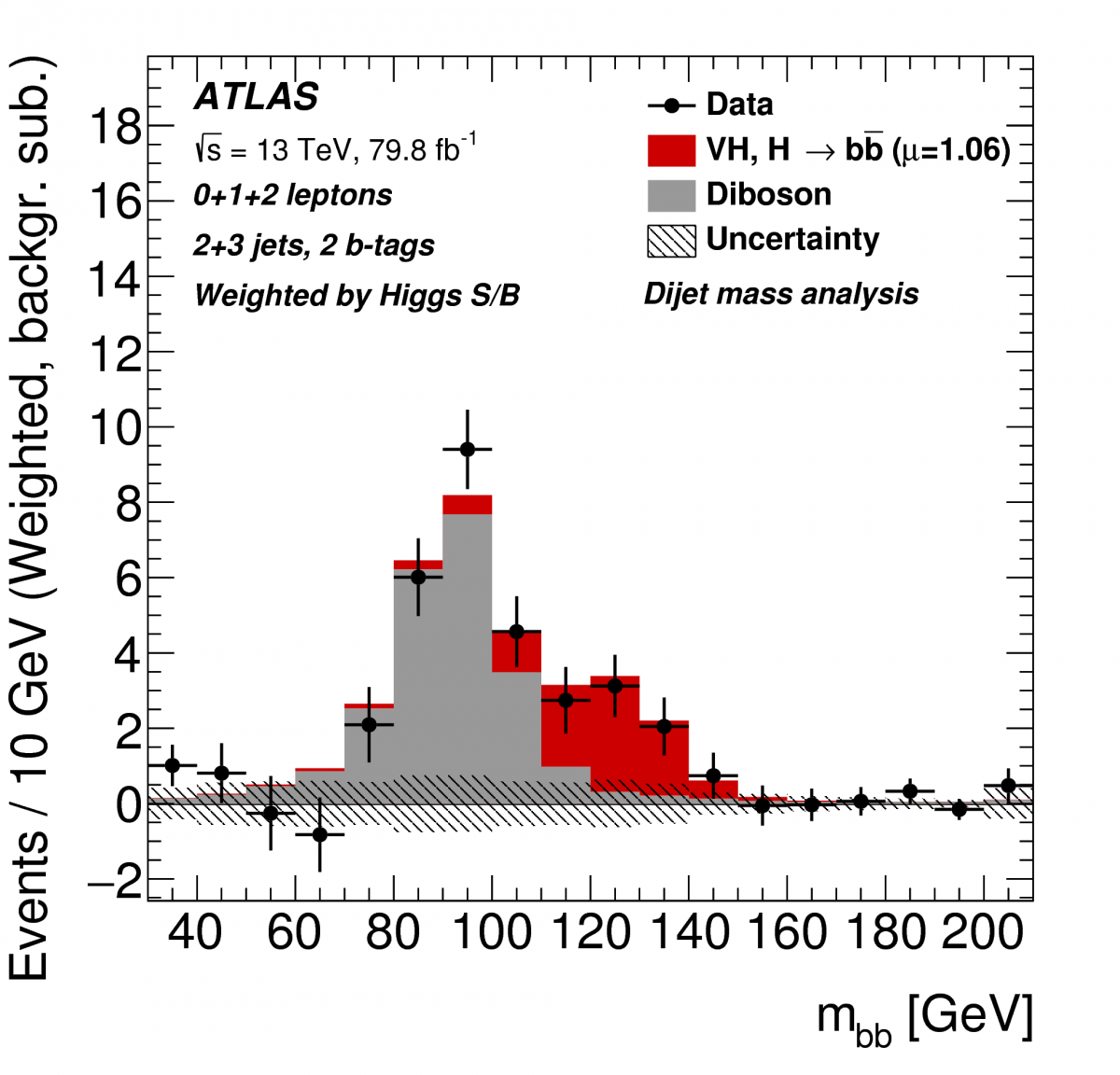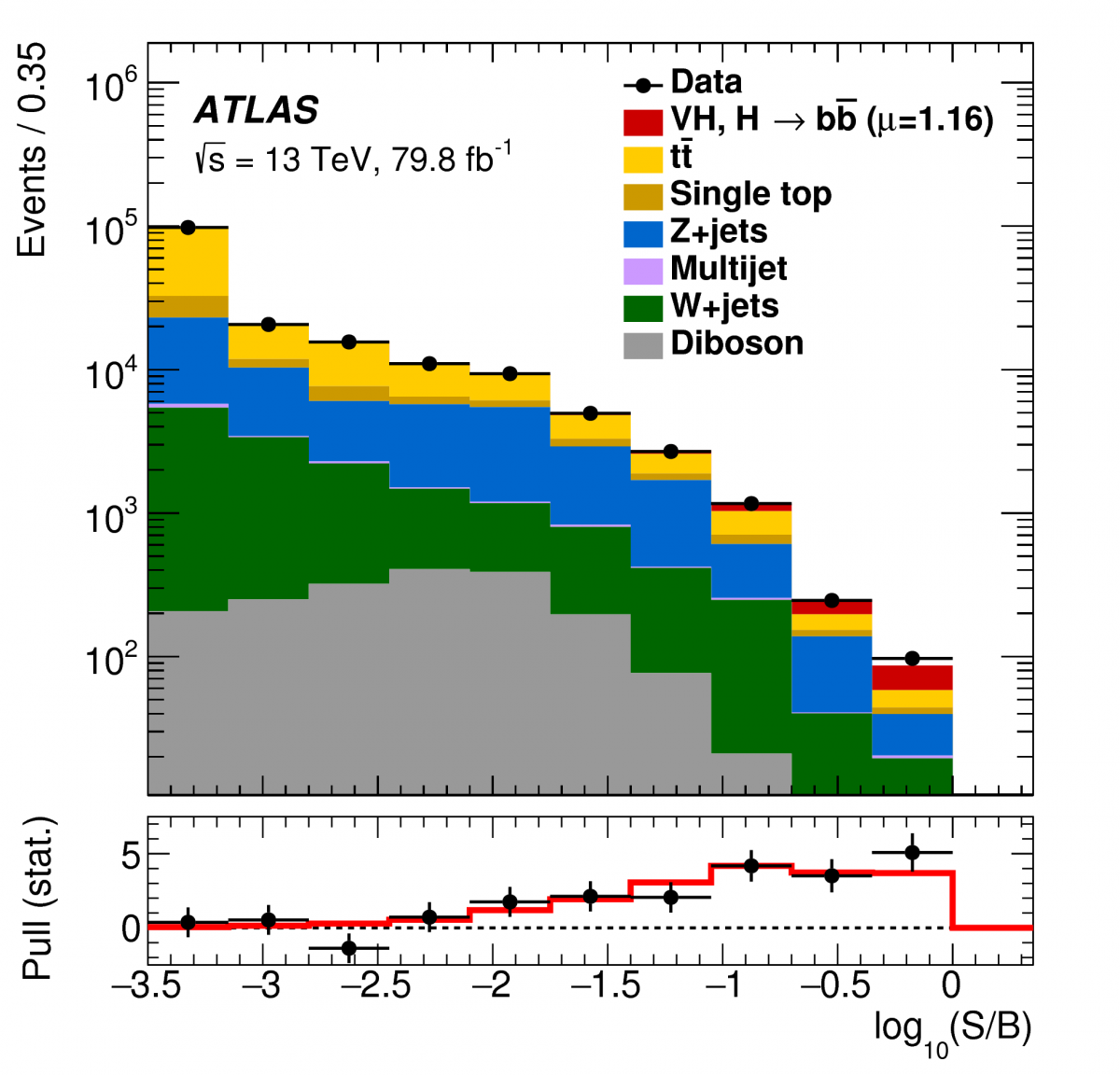Higgs boson observed decaying to b quarks – at last!
9 July 2018 | By
The Brout-Englert-Higgs mechanism solves the apparent theoretical impossibility of weak vector bosons (W and Z) to have mass. The discovery of the Higgs boson in 2012 via its decays into photon, Z and W pairs was a triumph of the Standard Model built upon this mechanism. The Higgs field can also be used in an elegant way to provide mass to charged fermions (quarks and leptons) through interactions involving “Yukawa couplings”, with strength proportional to the particle mass. The observation of the Higgs boson decaying into pairs of τ leptons provided the first direct evidence of this type of interaction.
Six years after its discovery, ATLAS has observed about 30% of the Higgs boson decays predicted in the Standard Model. However, the favoured decay of the Higgs boson into a pair of b quarks (H→bb), which is expected to account for almost 60% of all possible decays, had remained elusive up to now. Observing this decay mode and measuring its rate is a mandatory step to confirm (or not…) the mass generation for fermions via Yukawa interactions, as predicted in the Standard Model.
Today, at the 2018 International Conference on High Energy Physics (ICHEP) in Seoul, the ATLAS experiment reported a preliminary result establishing the observation of the Higgs boson decaying into pairs of b quarks, furthermore at a rate consistent with the Standard Model prediction. In the community of particle physics (and beyond), for the detection of a process to be qualified as an “observation”, it is necessary to exclude at a level of one in three million the probability that it arises from a fluctuation of the background that could mimic the process in question. When such a probability is at the level of only one in a thousand, the detection is qualified as an “evidence”. Evidence of the H→bb decay was first provided at the Tevatron in 2012, and a year ago by the ATLAS and CMS Collaborations, independently.
Today, at the 2018 International Conference on High Energy Physics in Seoul, the ATLAS experiment reported a preliminary result establishing the observation of the Higgs boson decaying into pairs of b quarks.
Combing through the haystack of b quarks
Given the abundance of the H→bb decay, and how much rarer decay modes such as H→γγ had already been observed at the time of discovery, why did it take so long to achieve this observation?
The main reason: the most copious production process for the Higgs boson in proton-proton interactions leads to just a pair of particle jets originating from the fragmentation of b quarks (b-jets). These are almost impossible to distinguish from the overwhelming background of b-quark pairs produced via the strong interaction (quantum chromodynamics or QCD). To overcome this challenge, it was necessary to consider production processes that are less copious, but exhibit features not present in QCD. The most effective of these is the associated production of the Higgs boson with a vector boson, W or Z. The leptonic decays, W→ℓν, Z→ℓℓ and Z→νν (where ℓ stands for an electron or a muon) provide signatures that allow for efficient triggering and powerful QCD background reduction.
However, the Higgs boson signal remains orders of magnitude smaller than the remaining backgrounds arising from top quark or vector boson production, which lead to similar signatures. For instance, a top quark pair can decay as tt→[(W→ℓν)b][(W→qq)b] with a final state containing an electron or a muon and two b quarks, exactly as the (W→ℓν)(H→bb) signal.
The main handle to discriminate the signal from such backgrounds is the invariant mass, mbb, of pairs of b-jets identified by sophisticated “b-tagging” algorithms. An example of such a mass distribution is shown in Figure 1, where the sum of the signal and background components is confronted to the data.


When all WH and ZH channels are combined and the backgrounds (apart from WZ and ZZ production) subtracted from the data, the distribution shown in Figure 2 exhibits a clear peak arising from Z boson decays to b-quark pairs, which validates the analysis procedure. The shoulder on the upper side is consistent in shape and rate with the expectation from Higgs boson production.
This is, however, not sufficient to reach the level of detection that can be qualified as observation. To this end, the mass of the b-jet pair is combined with other kinematic variables that show distinct differences between the signal and the various backgrounds, for instance the angular separation between the two b-jets, or the transverse momentum of the associated vector boson. This combination of multiple variables is performed using the technique of boosted decision trees (BDTs). A combination of the BDT outputs from all channels, reordered in terms of signal-to-background ratio, is shown in Figure 3. It can be seen that the signal closely follows the distribution expected from the Standard Model. The BDT outputs are subjected to a sophisticated statistical analysis to extract the “significance” of the signal. This is another way to measure the probability of a fake observation in terms of standard deviations, σ, of a Gaussian distribution. The magic number corresponding to the observation of a signal is 5σ.
All four primary Higgs boson production modes at hadron colliders have now been observed, of which two only this year.
Observation achieved!

The analysis of 13 TeV data collected by ATLAS during Run 2 of the LHC in 2015, 2016 and 2017 leads to a significance of 4.9σ – alone almost sufficient to claim observation. This result was combined with those from a similar analysis of Run 1 data and from other searches by ATLAS for the H→bb decay mode, namely where the Higgs boson is produced in association with a top quark pair or via a process known as vector boson fusion (VBF). The significance achieved by this combination is 5.4σ.
Furthermore, combining the present analysis with others that target Higgs boson decays to pairs of photons and Z bosons measured at 13 TeV provides the observation at 5.3σ of associated VH (V = Z or W) production, in agreement with the Standard Model prediction. All four primary Higgs boson production modes at hadron colliders have now been observed, of which two only this year. In order of discovery: (1) fusion of gluons to a Higgs boson, (2) fusion of weak bosons to a Higgs boson, (3) associated production of a Higgs boson with two top quarks, and (4) associated production of a Higgs boson with a weak boson.
With these observations, a new era of detailed measurements in the Higgs sector opens up, through which the Standard Model will be further challenged.
Update: This briefing was updated on 28 August 2018, replacing prelimary plots with the final ones submitted to Phys. Lett. B.
Links:
- Observation of H → bb decays and VH production with the ATLAS detector (arXiv:1808.08238, submitted to Phys. Lett. B.)
- ICHEP 2018 presentation by Tancredi Carli: Highlights from the ATLAS and ALICE Experiments
- ICHEP 2018 presentation by Giacinto Piacquadio: Higgs Boson Measurements from ATLAS and CMS
- Beyond any doubt: Higgs boson couples to the heaviest lepton, Physics Briefing, 8 June 2018
- New ATLAS result establishes production of Higgs boson in association with top quarks, Physics Briefing, 4 June 2018
- A first LHC sighting of the Higgs boson in its favourite decay, Physics Briefing, 6 July 2017
- See also the full lists of ATLAS Physics Papers and ATLAS Conference Notes.



